Die Stabilität und Dispergierbarkeit der Batterie Schlämme haben einen wichtigen Einfluss auf die Eigenschaften der Elektroden und der Endbearbeitung Batterieprodukte. Wie lässt sich also die Stabilität und Dispergierbarkeit von Batterieschlamm charakterisieren?
Charakterisierungsmethode der Batterie Güllestabilität
1. Solid-Content-Methode
Die Methode zur Prüfung des Feststoffgehalts ist kostengünstig und einfach zu testende Methode. Das Prinzip besteht darin, die Gülle in einen Behälter zu füllen und nehmen Sie in regelmäßigen Abständen am selben Ort Proben zum Testen und Analysieren der feste Inhalt. Durch die Beurteilung des Unterschieds im Feststoffgehalt wird die Stabilität von Die Lithiumbatterie-Aufschlämmung kann beurteilt werden, um festzustellen, ob sie vorhanden ist Sedimentation, Schichtung und andere Phänomene.
2. Viskositätsmethode
Die Viskositätstestmethode kann auch spiegeln grundsätzlich die Stabilität der Gülle wider. Sein Prinzip besteht darin, das zu platzieren Gülle in einen Behälter geben und in regelmäßigen Abständen die Viskosität prüfen. Der Die Stabilität der Aufschlämmung kann anhand der Viskositätsänderung beurteilt werden.
3. Stabilität Analysator
Die Verwendung von Der Stabilitätsanalysator kann mit Daten sprechen. Beispielsweise haben Sung et al. verwendet a Stabilitätsanalysator zur Überwachung der Lichtdurchlässigkeitsänderungen verschiedener pH-Werte Schlämme mit PAA als Bindemittel innerhalb von 12 Stunden. Die anfängliche Lichtdurchlässigkeit und 12-Stunden-Änderungswerte des Neutralleiters Gülle war kleiner. Da Rußmaterialien Licht absorbieren, Eine geringere Lichtdurchlässigkeit weist auf eine bessere Dispersion von Ruß hin Partikel und kleinere Mikroagglomerate haben größere spezifische Oberflächen, Dadurch wird die Lichtabsorptionseffizienz verbessert. Gleichzeitig das Kleine Eine Änderung der Lichtdurchlässigkeit der Aufschlämmung innerhalb von 12 Stunden zeigt dies an Die Aufschlämmung weist während des statischen Prozesses eine gute Dispersionsstabilität auf, wie in gezeigt die Abbildung unten.
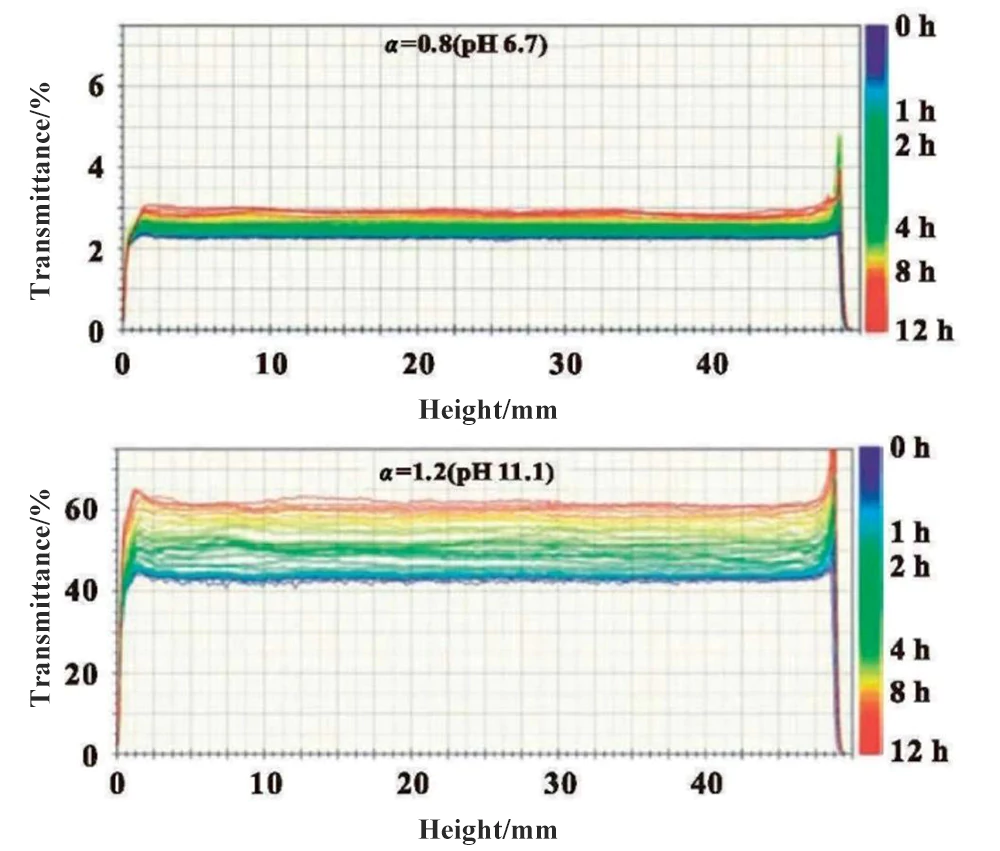
4. Charakterisierung des Zeta-Potentials
Zeta-Potenzial bezieht sich auf das Potenzial der Scherebene, auch Elektrokinetik genannt Potential oder elektromotorische Kraft und ist ein wichtiger Indikator für die Charakterisierung die Stabilität kolloidaler Dispersionen. Je kleiner die Moleküle bzw. dispergierter sind Partikel, desto höher ist der Absolutwert des Zeta-Potentials (positiv bzw negativ) und je stabiler das System, d. h. die Auflösung bzw Dispersion kann der Aggregation widerstehen. Umgekehrt gilt: Je niedriger das Zeta-Potenzial (positiv oder negativ), desto mehr neigt es zur Koagulation oder Aggregation, d. h. die Anziehung übersteigt die Abstoßung, die Streuung wird zerstört und Es kommt zu einer Koagulation oder Aggregation.
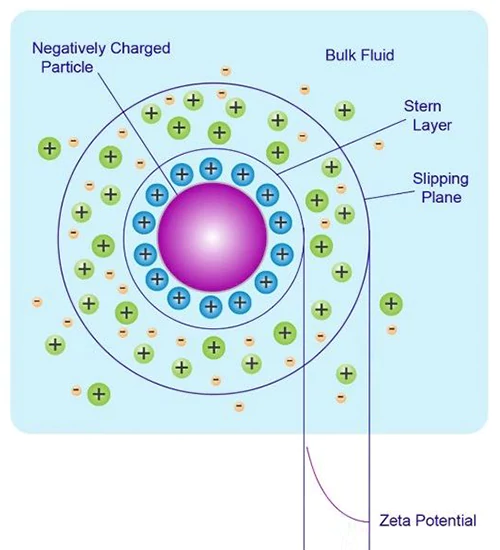
Charakterisierung Verfahren zur Dispersion von Batterieschlamm
1. Feinheit
Feinheit ist ein wichtiger Leistungsindikator der Batterieschlamm, der widerspiegeln kann Informationen wie Schlammpartikelgröße und -dispersion. Der Feinheitswert kann verwendet werden, um zu verstehen, ob die Partikel in der Aufschlämmung dispergiert sind und ob die Agglomerate desagglomeriert sind.
2. Membran Impedanz
Lithiumbatterie Eine Aufschlämmung ist ein Fest-Flüssigkeits-Mischsystem, das durch Dispergieren von Elektrodenaktivstoffen entsteht Materialien und Leitmittel in einer Bindemittellösung. Laut der Prinzip des Vier-Sonden-Membranimpedanztests, der Güllemembranimpedanz wird getestet. Der Verteilungszustand des leitfähigen Mittels in der Aufschlämmung kann sein quantitativ anhand des spezifischen Widerstands analysiert, um den Dispersionseffekt zu beurteilen die Gülle. Der spezifische Testprozess ist: Verwenden Sie einen Filmapplikator, um gleichmäßig zu beschichten Die Aufschlämmung auf die Isolierfolie auftragen, dann erhitzen und trocknen, die Dicke messen Schneiden Sie nach dem Trocknen der Beschichtung die Probe ab und die Größe entspricht dem Unendlichen Erfordernis. Verwenden Sie abschließend vier Sonden, um die Elektrodenmembran zu messen Impedanz und berechnen Sie den spezifischen Widerstand basierend auf der Dicke.
3. Scannen Elektronenmikroskopie/Energiespektrumanalyse/Kryoelektronenmikroskopie
Rasterelektron Mithilfe der Mikroskopie (REM) kann die Morphologie der Batterie direkt beobachtet werden Schlamm und arbeiten mit der Energiespektrumanalyse (EDS) zusammen, um die zu analysieren Streuung jeder Komponente. Allerdings ist bei der Probenvorbereitung das Trocknen von Die Aufschlämmung kann während dieses Prozesses zu einer Umverteilung führen Komponenten. Mit der Kryo-Elektronenmikroskopie (Kryo-SEM) kann das Original erhalten bleiben Verteilungszustand der Güllebestandteile, so wie es seit Kurzem der Fall ist Wird bei der Analyse der Schlammeigenschaften verwendet.
4. Elektrode CT-Bildgebung
Elektroden-CT Bildgebung kann den Dispersionszustand von Partikeln direkt beobachten Elektrode. Wie in der folgenden Abbildung dargestellt, gibt es mehr große Partikel agglomeriert in der Elektrode in Abbildung a, die agglomerierten Partikel in der Elektrode in Abbildung b sind deutlich reduziert, und es gibt fast keine agglomerierte große Partikel in der Elektrode in Abbildung c.
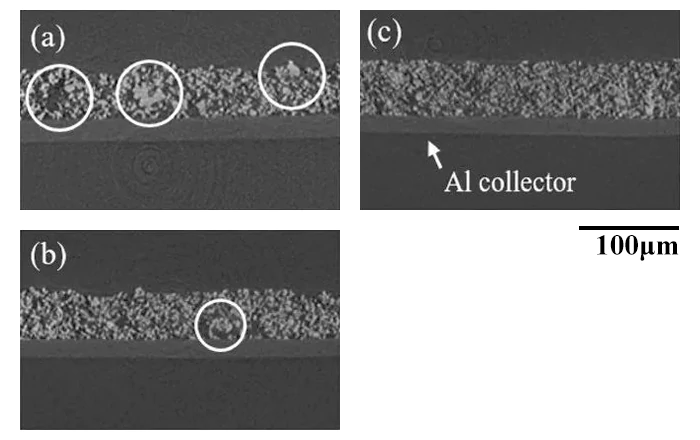
5. Laser Beugungsmesstechnik
Laserbeugung Die Messtechnik nutzt dazu die Fresnel-Streutheorie und die Fraunhofer-Theorie Partikelgröße und -verteilung ermitteln. Der Laser-Partikelgrößenanalysator basiert Diese Technologie zeichnet sich durch eine hohe Messgenauigkeit, gute Wiederholbarkeit und kurze Zeit aus Messzeit. Es wurde häufig in Batteriefabriken zum Testen eingesetzt Partikelgröße der Gülle in Batterien.
6. Analysemethode der elektrochemischen Impedanzspektroskopie
Zum Beispiel Wang et al. verwendete die elektrochemische Impedanzspektroskopie-Analysemethode (EIS), um direkt anAnalysieren Sie das Impedanzspektrum der flüssigen Aufschlämmung und erhalten Sie die elektrochemische Eigenschaften der Aufschlämmung bei unterschiedlichen Partikelkonzentrationen. Und durch die Impedanzspektrum-Anpassungsergebnisse wird eine Bewertungsmethode für die interne Partikelverteilungsstruktur der Elektrodenaufschlämmung basiert auf Das Parameter-Ersatzschaltbildmodell wurde etabliert, das ein neues lieferte Idee zur Online-Messung und Online-Auswertung des internen Ungleichmäßige Struktur des Lithium-Ionen-Batterieschlamms. Das EIS-Testprinzip ist in der Abbildung dargestellt.
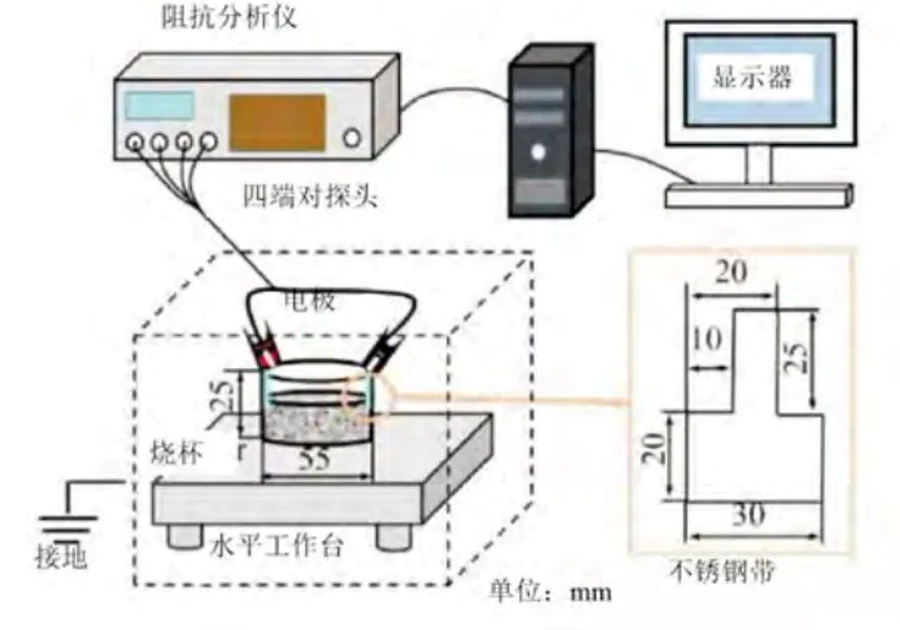
Methoden für Charakterisiert sowohl die Stabilität der Aufschlämmung als auch die Dispergierbarkeit
1. Rheometer
Die viskoelastischen Eigenschaften der Aufschlämmung sind gekennzeichnet durch die relativen Werte des Speichermoduls (Gâ²) und des Verlustmoduls (Gâ³). Der Speichermodul Gâ², auch bekannt als Der Elastizitätsmodul stellt die Kapazität dar, die gespeichert wird, wenn die Aufschlämmung einer Belastung ausgesetzt wird reversible elastische Verformung und ist ein Maß für die elastische Verformung von die Gülle. Der Verlustmodul Gâ³, auch bekannt als Der Viskositätsmodul stellt die Energie dar, die verbraucht wird, wenn die Aufschlämmung durchläuft irreversible Verformung und ist ein Maß für die viskose Verformung des Gülle. Im Frequenzscan kann anhand der relativen Größe von Gâ² und Gâ³ und der Bewertung der Empfindlichkeit von Gâ² gegenüber der Kreisfrequenz reflektiert werden, ob die Die Gülle befindet sich in einem flüssigen oder feststoffähnlichen Zustand. Im Niederfrequenzbereich gilt Gâ²Gâ³und je größer der Unterschied, desto größer bessere Stabilität der Gülle. Wie in der Abbildung unten gezeigt, ist die Stabilität von natürlichem Graphitschlamm ist besser als der von synthetischem Graphitschlamm.

(2) Änderungenn Viskosität mit Scherrate
Die Viskosität von Eine Aufschlämmung verändert sich normalerweise mit der Schergeschwindigkeit. Wenn Scherverdünnungsverhalten vorliegt, Es gibt weiche Agglomerate in der Aufschlämmung, die durch Scherung leicht zerstört werden Stress. Im Gegenteil, das Vorhandensein einer Scherverdickung weist normalerweise darauf hin dass sich in der Gülle harte aggregierte Partikel befinden. Allgemein gesprochen, Aufschlämmungen mit schnellerer Scherverdünnung weisen tendenziell eine bessere Dispergierbarkeit auf. Die Zerstörung des Bindemittels durch Scherkräfte bleibt außer Acht. Wie in der Abbildung gezeigt Unten weist die durch den Hohlkreis dargestellte Aufschlämmung eine bessere Dispergierbarkeit auf als die anderen beiden Aufschlämmungen.
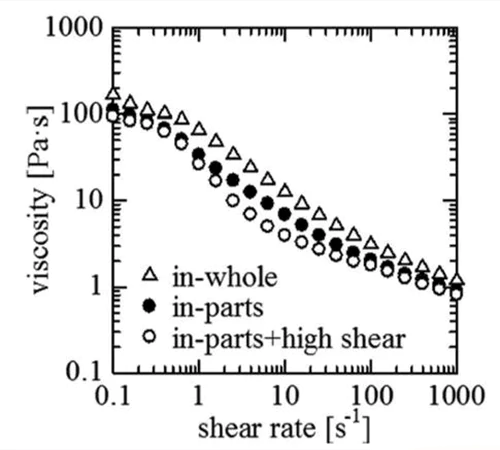
(3) Ausbeute Stresstest
Die Fließgrenze In der Rheologie wird die angelegte Spannung definiert, bei der irreversibler Kunststoff entsteht Die Verformung wird zunächst an der Probe beobachtet. Theoretisch beträgt die Streckgrenze die minimale Spannung, die erforderlich ist, um den Fluss einzuleiten. Die Ertragsanalyse ist wichtig für alle komplex strukturierten Flüssigkeiten. Es hilft, das Produkt besser zu verstehen Leistung wie Haltbarkeit und Stabilität gegen Sedimentation oder Phase Trennung. Es gibt eine Vielzahl rheologischer Methoden, die hierfür eingesetzt werden können Bestimmen Sie die Fließgrenze. Die folgende Abbildung zeigt die Fließspannungsanalyse unter Verwendung der Scherfluss-Rampen-Down-Methode. Aus den Testergebnissen ist es ersichtlich dass bei moderaten Schergeschwindigkeiten die Scherspannung mit zunehmender Schergeschwindigkeit abnimmt nimmt ab. Wenn jedoch die Schergeschwindigkeit weiter verringert wird, ändert sich die Spannungskurve erreicht ein stabiles Niveau und ist unabhängig von der Rate. Dieser stabile Spannungswert wird Fließgrenze genannt. Gleichzeitig wird das gemessene „scheinbare“ Die Kurve der „Viskosität“ wird unendlich und steht in einem linearen Zusammenhang mit der Scherrate, wenn die Steigung -1 beträgt.
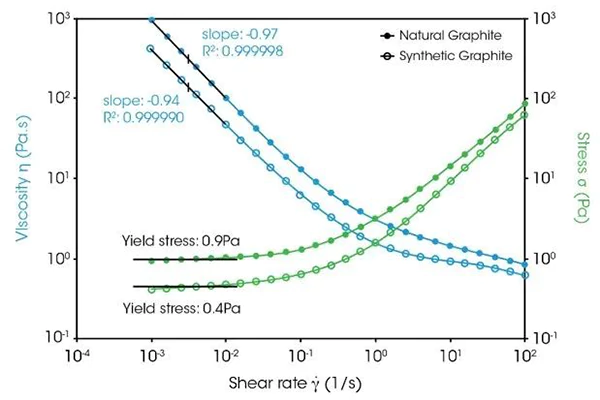
Da synthetisch Graphit hat eine größere Partikelgröße und eine unregelmäßigere Partikelform Die Gülle weist eine geringere Fließspannung und eine schwächere Netzwerkstruktur auf. Daher, Diese synthetische Graphitaufschlämmungsprobe ist anfälliger für Sedimentation und Phasentrennung. Die Sedimentation der Gülle kann zu einer ungleichmäßigen Verteilung führen aktive Materialien auf der Elektrode, wodurch die Batterieleistung verringert wird.
(4) Thixotropie
Nach dem Beschichten Die Batterieschlämme nivelliert sich unter der Wirkung der Schwerkraft und der Oberflächenspannung am Stromabnehmer. Im Bereich niedriger Schergeschwindigkeiten hofft man, dass die Die Viskosität kehrt vor dem Beschichten allmählich auf die hohe Viskosität zurück. Davor kehrt zu hoher Viskosität zurück, die Viskosität der Aufschlämmung ist immer noch relativ niedrig, lässt sich leicht nivellieren und die Beschichtungsoberfläche ist glatt und gleichmäßig dick. Der Die Erholungszeit sollte nicht zu lang oder zu kurz sein. Wenn die Erholungszeit auch ist lange, die Viskosität der Aufschlämmung wird während des Einebnungsvorgangs zu niedrig sein, und es kommt leicht zu Rückständen oder die Dicke der Unterkante ist höher als die Dicke der oberen Beschichtung. Wenn die Zeit zu kurz ist, die Gülle wird keine Zeit zum Leveln haben.
2. Gülle Widerstandsmesser
Die Gülle Der Widerstandsparameter weist eine signifikante Korrelation mit der Schlammformel auf. Art und Inhalt des Leitmittels, Art und Inhalt des Bindemittel usw. Nachdem die Aufschlämmung gerührt und eine Zeit lang stehen gelassen wurde Mit der Zeit kann es zur Sedimentation des Gels kommen und der Widerstandswert wird ebenfalls angezeigt unterschiedliche Grade der Veränderung. Daher kann der Schlammwiderstand als verwendet werden Methode zur Charakterisierung der Gleichmäßigkeit und Stabilität der elektrischen Eigenschaften der Aufschlämmung Eigenschaften.
Testmethode: put Geben Sie eine bestimmte Menge Gülle (ca. 80 ml) in den Messbecher aus Glas und setzen Sie einen ein Reinigen Sie den Elektrodenstift, starten Sie die Software und testen Sie die Änderung des Schlammwiderstands an drei Elektrodenpaaren über die Zeit messen und im Dokument speichern.
Testparameter: spezifischer Widerstand, Temperatur, Zeit
Berechnung Formel: Spezifischer Widerstand (Ω*cm):Ρe=U/I * S/L
Eigenschaften:
1. Trennen Sie die Spannungs- und Stromleitungen eliminieren den Einfluss der Induktivität auf die Spannung Messung und Verbesserung der Genauigkeit der Widerstandserkennung.
2. Die 10mm Der Durchmesser der Scheibenelektrode gewährleistet eine relativ große Kontaktfläche mit der Probe und reduziert den Testfehler.
3. Der Änderung des spezifischen Widerstands an drei Positionen in der vertikalen Richtung der Aufschlämmung über die Zeit kann in Echtzeit überwacht werden.
Widerstand Messbereich: 2,5Ω*cm~50MΩ*cm
Widerstand Messgenauigkeit:±0,5%